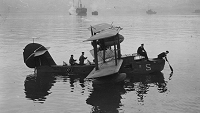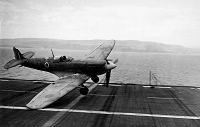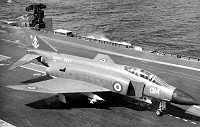





The first squadrons were equipped with biplanes, the majority of which were amphibians or Landplanes adapted with floats for operations as Ship's flights. Biplanes continued to be used throughout the Second World War but monoplanes quickly began to serve in in all roles,
Torped Bomber & Reconnaissance (TBR), Torpedo Spotter & Reconnaissance (TSR), Fighter, and trainers.
Monoplanes had replaced the slower, more vulnerable biplanes after the war and a new type of flying machine also arrived in the post-war era, the helicopter. So successful were these versatile machines that they replaced biplanes in the roles of ship’s flight and anti-submarine operations, transport and Search and Rescue. They also proved to be suitable for troop delivery operations in the Commando Support role.


Early petrol engine, propeller driven naval aircraft were slow and design of aero-engines and propellers which allowed newer monoplanes to enter service and to achieve superior speeds and better handling. High performance engines, such as the Rolls-Royce Merlin and Griffon helped
Fleet Air Arm squadrons to dominate the skies into the post-war years.
During the Korean conflict Jet powered aircraft began entering service and the propeller driven fighters could not compete in aerial combat. The Fleet Air Arm entered the Jet age with Supermarine Attacker in 1951, the first of a long line of jet aircraft to operate from carriers into the 21st century. Helicopters adopted the jet engine with Gas Turbines replacing piston engines beginning with the versatile Westland Wessex in 1961.
On May 24th 1939 administrative control of the Fleet Air Arm, the naval aviation wing of the Royal Navy, was transferred to the Board of Admiralty from the Royal Air Force under the "Inskip Award". Formed on April 1st 1924 the Fleet Air Arm encompassed all RAF aircraft that operated from carriers and other fighting ships. Renamed the Air Branch of the Royal Navy, at the onset of the Second World War, the Fleet Air Arm consisted of only 20 squadrons and 232 aircraft.
Squadrons were to be numbered in two blocks – 800 – 899 for first-line and 700-799 for second-line units; once these numbers were exhausted 1700 and 1800 series numbers were allocated. Squadron numbers in further divided into blocks, organised by type and function:
Nos.800 to 809 Single-seat fighter squadrons in carriers.
Nos.810 to 819 Torpedo bomber squadrons in carriers, later torpedo spotter reconnaissance and torpedo bomber reconnaissance squadrons.
Nos.820 to 859 Spotter reconnaissance squadrons, later torpedo spotter reconnaissance and torpedo bomber reconnaissance squadrons.
Nos.860 to 869 Torpedo bomber reconnaissance squadrons. Later reserved for Dutch-manned and then Dutch Navy squadrons.
Nos.870 to 879 Single-seat fighter squadrons. Later reserved for Royal Canadian Navy use.
Nos.880 to 899 Single - seat fighter squadrons in carriers.
Nos.1700 to 1749 Torpedo bomber reconnaissance squadrons, reallocated to amphibian bomber reconnaissance squadrons.
Nos.1750 to 1769 Single-seat fighter squadrons (not taken up).
Nos.1770 to 1799 Two-seat fighter squadrons.
Nos.I800 to 1809 Torpedo bomber reconnaissance squadrons (not taken up)
Nos.1810 to 1829 Dive-bomber squadrons.
Nos.1830 to 1899 Single-seat fighter squadrons.
Nos.700 to 749 initially for Catapult flights, later becoming catapult squadrons. When these ceased to exist the range became available for training and ancillary squadrons.
Nos.700 to 710 were earmarked for use by amphibian and floatplane squadrons in 1943, but this later lapsed.
Nos.750 to 799 Training and ancillary squadrons.
Nos.1830 to 1844 Used for Royal Naval Volunteer Reserve squadrons, and latterly RNR squadrons.
1770 Squadron - history added Julyr2025
882 Squadron - history added September2024
851 Squadron - history added December2023
894 Squadron - history added March 2023
887 Squadron - history updated March 2023
879 Squadron - history updated December2022
853 Squadron - history updated November2022
1831 RNVR Squadron - history added September 2022
881 Squadron - history added August 2022
1830 Squadron - history added December 2021
1832 Squadron - history added December 2021
1833 Squadron - history added December 2021
1840 Squadron - history added November 2021
1836 Squadron - history added September 2021
1834 Squadron - history added September 2021
© 1999-2026 The Royal Navy Research Archive All Rights Reserved Powered by W3,CSS